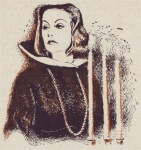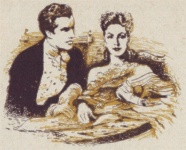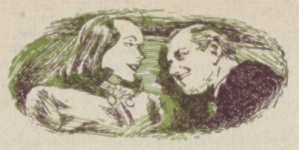GRETA GARBO
Sphinx Without a Secret

by HELEN WORDEN One Hollywood's most glamorous star,
today she is a recluse who denies her identity
GRETA GARBO WAS once called the world's greatest movie actress. Thousands of adoring fans trailed her wherever she went. At the height of her career some 15 years ago, 5,000 men, women and children waited six hours on the Stockholm docks to catch a glimpse of her walking down the gangplank. When she finally appeared, the mob surged forward and 100 people were shoved into the water.
Here and abroad, police were called out again and again to protect her. Never in Hollywood history had any star aroused such frenzied interest. There are hundreds of clippings about her in the New York Public Library, including endless raves from critics.
Said Alistair Cooke: “Garbo manages, because she is a supremely beautiful woman, to make beauty look like a mark of religion.” Jack Hitt wrote: “Garbo is poetry, sunrise and great music.”
Despite all this acclaim, Greta has been in seclusion for nearly eight years, using another name, dropping her eyes when she meets people, and doing all she can to blot out the person that was the famous Garbo.
Meanwhile, her friends ask: Is Garbo still determined to turn her back on a world without the man she loved, or is she caught in a web of indecision which has been gripping her since the failure, in 1941, of the last film she made, Two-Faced Woman?
What evidence is there to support the former theory? Arnold Genthe, famous photographer, told me in 1942 that Maurice Stiller, the Swedish film director who discovered Garbo, was the only man she ever loved. “After Stiller died, she began shutting people put of her life,” he said.
She was 25 when Stiller died in 1930 in Stockholm. All that she wanted so desperately–money, fame, possessions–-became meaningless without him.
“After he died I could not sleep, eat or work,” she said. “I wanted to go back to Sweden but they said to me, ‘You must be faithful to us and your work.” I told them, ‘You will have something dead on the screen.'”
However, if she loved Stiller so deeply, how can anyone explain her friendship with Rouben Mamoulian, her director; the romance in Hollywood with the late John Gilbert, her leading man; her deep admiration for Leopold Stokowski, the symphony conductor; or the subsequent rumors of her engagement to Bengamin Gayelord Hauser, the Manhattan diet expert?
The answer may be the one she gave friends who were puzzling over Isadora Duncan's life. Garbo, who had been sitting inarticulate in a corner, suddenly spoke. “Perhaps,” she said quietly, “she was forgetting for a little while the pain of being a human being.”
More recently, she may have been striving to forget the Garbo of the intervening years. This might explain her actions when I saw her recently in the lobby of the Ritz Tower, her New York City home. She glided mysteriously out of an elevator, her head averted, her eyes downcast. Wisps of ash-blonde hair straggled from beneath a spooky hat. A worn tan raincoat flapped about her thin body. Her black rubbers were scuffed. Her brown bag was battered. She looked as if she didn't have a cent in the world.
Yet, from 1925 to 1941, she was among Hollywood's highest-paid stars and today is rated as one of America's richest women. As she turned into the 57th Street corridor, she collided with a chow dog.
“I'm sorry,” she apologized to its owner, then leaned over to pat the dog's head. “What a beautiful animal!”
“I'm glad you like my dog, Miss Garbo,” said its owner.
Garbo shrank back into the shadows. “I'm not Miss Garbo, I'm Harriet Brown.” The next moment she was gone.
At the 57th Street entrance, a flock of high-school boys and girls waited with open autograph books. Greer Garson was also stopping at the hotel. Garbo drew up her coat collar, yanked down her hat and hurried off in the rain.
“Who's that?” asked a girl.
“That's Greta Garbo,” said the doorman.
“Who's Garbo?”
Today, a whole generation is growing up which has neither seen nor heard of this woman whom Cecil Beaton, the noted English photographer, once described as “being as beautiful as the Aurora Borealis.” Yet her obscurity today is no less remarkable than that with which she began life.
GRETA GRABO WAS BORN on September 18, 1905, in a Stockholm tenement. Her parents were Sven and Louvisa Gustaffson, and she was named Anna. Her father, a mechanic, died when she was 14. Poverty drove her to work.

Her first job was mixing lather and washing towels in a barber-shop. Her second was as a milliner's apprentice in a department store, where her big blue eyes, yellow curls and cameo profile won her a job as the model for illustrations in the store's catalogue.
A Captain Ring, who was making a commercial movie of the shop, noted that Anna Gustaffson photographed well, so he gave her a part. The following year, Ring used her in a propaganda film for the Orient. Then, at 17, she landed her first professional movie role–as a bathing beauty in a comedy called Peter the Tramp.
Anna wanted dramatic training but couldn't afford it. Frans Enwall, private theatrical coach, arranged a tryout for a Royal Dramatic Academy scholarship. She won. In 1922 and 1923, she concentrated on voice culture, fencing, dancing and dramatics. During vacation she acted in real plays at the Royal Theater and drew a real salary–$10 a week.
In 1923 she met Stiller. Later, she described that eventful encounter to a friend: “On an streetcar in Sweden I saw a man. He was like a mountain–colossal. He looked as though he belonged to some other race of men that did not walk with us. I thought of him often.
“Once day he came to the Royal Dramatic School in search of someone to play the part in a book which had taken the Nobel Prize. He was one of the great screen directors of the world. He gave me the woman in Gösta Berling to do–without my ever having acted before.
“'Do you understand her?' he asked me. I answered, ‘I understand.' And it was well with us from the beginning.”
Stiller had brooding gray eyes, black hair touched by gray, and stood over six feet. He was twice Anna's age and Europe's top director. Realizing her potentialities, he changed her name to Greta Garbo and began training her.
In Gösta Berling, she was an instantaneous success. At the première in Berlin, they appeared on the stage hand in hand, and from that moment onward romantic rumors surrounded them. It was stated, then denied, that they had been married in Constantinople. Actually no one knew.
Stiller was a better director than businessman. His company failed in Constantinople. He was not rich. Meanwhile, Garbo had become his religion, his life: all his plans pivoted around her. She must go to Hollywood. But without money, how could he accomplish this?
Louis B. Mayer of Metro-Goldwyn-Mayer, then traveling in Europe, saw the film Gösta Berling. He wired Stiller, offering a contract. Stiller accepted on one condition–Greta must go with him. Mayer vaguely recalled her as an unknown young actress in Gösta Berling. After all, who was Garbo?
“The greatest actress in all Europe!” said Stiller.
Mayer agreed to give Garbo a screen test, so Stiller borrowed $6,500 and sailed with Garbo for America in July, 1925. After weeks of interviews and tests in New York, Garbo signed an $350-a-week contract with M-G-M and left for Hollywood with Stiller.
He had become her world, she his. But now he impressed upon her the fact that she must learn to stand alone and, deliberately, he began to withdraw from her life. She was given the feminine lead in The Torrent. Monta Bell, not Stiller, directed. She agreed to make a second picture, The Temptress, is Stiller would direct it. Instead, he took Hôtel Imperial with Pola Negri.
Shortly after Stiller completed this film, he returned to Sweden without Garbo. Friends believed that, having launched Greta on a great career, he purposely withdrew. She was numb for weeks, speaking to no one, seeing few outside those working with her on The Temptress. Then Stiller died in far-off Stockholm.
“In all the world there is no place for me,” she mourned to a friend. “Not in Sweden, where my mother is, nor here, where my work is. I look everywhere–everywhere–and I do not understand. I am thinking that perhaps the world is not for people like myself.”
The she remembered Stiller's words: “Your work is all you can be sure of.”
Between 1925 and 1941, Garbo starred in 25 films. Her first two movies–The Torrent and The Temptress–completely sold her to the public. Then she did a series with John Gilbert–Flesh and the Devil, Love, Woman of Affairs, Queen Christina and Anna Karenina.
After Anna Karenina she went into a decline, then came up with Ninotchka , which proved her real talents as a comedienne. Her best personal performance was given in Grand Hote, but to most observers Anna Christie , her first talkie, is still her finest picture. During those years of harvest, her salary was variously estimated at from $7,500 a week to $500,000 a year.
As she continued up the ladder, each of her screen lovers was reputed to be genuinely in love with her. Clark Gable, Charles Boyer, Melvyn Douglas, Robert Montgomery, Conrad Nagel, John Gilbert and Ramon Novarro were among those mentioned.
Her only real screen failure was Two-Faced Woman. Strictly speaking it was not a failure, for it played to packed house; but it was condemned by the Legion of Decency, scored by the Catholic Review, and blasted by Cardinal Spellman.
It was her last movie. Little has been heard of her since. What is she like at 43?
The once-familiar disdain has been superseded by a tolerant grandeur. Specifically, this means a balancing of two features–a gentling of the eyes and a hardening of the mouth. When she landed in America, she was 19 and plump. Today she weighs 130 pounds and wears size-12 dresses.
Greta worships the sun. She likes rooms that face the sun, terraces where she can lie nude in the sun, barefoot walks on Malibu Beach in the sun. She washes her own straight, shoulder-length hair and dries it in the sun.

Under Hauser's influence, she has become a vegetarian. Every day when she is in New York, fresh vegetables and fruits are delivered to her hotel apartment. In the afternoon, she drops in at Kubie's Health Shop on East 57th Street for a swig of carrot juice.
They call her the recluse of Hollywood. But even the most consistent recluse must have go-betweens with the outside world. Garbo has three. Leland Hayward is her professional agent. The second is George Schlee, husband of Valentina, the dressmaker. The third is Frey Brown, an ex-resident of Reno and a friend of Hauser's, who has been variously identified as Garbo's real-estate and business agent.
Frequently she window-shops on Manhattan's Third Avenue with Brown. Her blonde hair blows in the wind and she strides along like a boy as they flit in and out of secondhand stores. New York picture dealers describe her as a pedestrian art connoisseur. She goes from gallery to gallery–questioning, studying trends, and analyzing old and new masters. She owns four Renoirs, one Soutine, a Modigliani and a Rouault.
Her taste in furniture is rococo–her favorite period at the moment being Louis XV and Italian 18th-century. Pieces in these periods are constantly being shipped from New York to her California home, in care of “Miss Harriet Brown.”
In 1943, she bought the Beverly Hills house of singer Gladys Swarthout. As Hollywood homes go it is simple–having neither swimming pool nor tennis court. Within its confines, Garbo seems content with her lonely life. Her only companion for the past six years has been a housekeeper. During the war she let her chauffeur go. She is her own gardener. Her closest friends are Salka Viertel, widow of a German movie director, Constance Collier, Clifton Webb, Ina Claire, Schlee, Hauser and Brown.
While she occasionally goes on a clothes-buying spree at Valentina's, paying as much as $395 for a plain street dress, she much prefers old corduroys and tweeds. She hates perfume, loves diamonds, adores fancy lingerie and never wears slips.
GRETA HAS NEVER been heard to say an unkind word about anyone, and those who have worked with her find her just. Once, she read and liked her script, but when she saw it in rehearsal changed her mind. Instead of letting M-G-M meet the bill, she paid all costs.
Garbo is independent yet prefers to have a man about to make decisions. Always she takes a man along when she shops. When neither Brown, Hauser nor Schlee can accompany her, she invites one of her many acquaintances among the dealers. To them she is Harriet Brown. Yet wherever they go, people exclaim: “There is Garbo!”
The more she shuns publicity, the more she attracts it. Does she seek seclusion because she wants to live with her memories of Stiller, or because, as some insist, she has been uncertain about her career since criticisms of Two-Faced Woman?
Ina Claire subscribes to the latter theory. “Garbo says she wants to return to the movies, but I don't think she does. She is still a great actress, but she does not wish to be connected with another failure.”
How dies George Schlee explain Garbo? I found him at his wife's luxurious dressing establishment on East 67th Street.
“Garbo is not the rosebuds-and-ribbon type,” he said. “She ist what she is–honest, direct, unassuming, terribly shy and passionately concerned with doing whatever she does to the best of her ability.
“She reminds me of Duse, whom I first saw in St. Petersburg. She had been in retirement 11 years and returned to greater triumphs than ever. This will happen to Garbo.”
Greta's last dealing with the press were characteristically unsatisfactory. When she returned from Sweden in 1946, Schlee arranged an interview on the ship's deck. Her face was expressionless and she winced as photographers' flashlights blazed. After answering a few obvious questions, she edged nervously toward the gangplank.
Her actions recalled a previous interview, when she said: “I hate, to be stared at. I know how the animals in the zoo feel when people poke them with little sticks.”
Hollywood directors are notoriously afraid of her. Yet when Woody Van Dyke took over a film she was to appear in, he got up courage to call on her to discuss it. He expected to meet an imperious, haughty and difficult woman. To his amazement Garbo greeted him with, “Come on, Turp! Let's have a few takes.”
Clarence Brown, the M-G-M director, probably had as much as anybody to do with Greta's success in America. When I asked him how the Garbo of today compared with the Garbo he directed in Flesh and the Devil, Anna Christie and Anna Karenina, he replied: “I see very little change. For me, she could play any age required for the part.”
Howard Dietz, dramatist and head publicity man for M-G-M, gave me the final word on Greta Garbo. “A lot of people think her snobbish,” he said. “But she isn't. It's only natural reticence. Garbo is no mystery. She makes me think of Oscar Wilde's line, ‘A sphinx without a secret.'” |